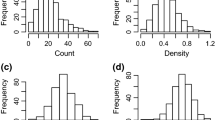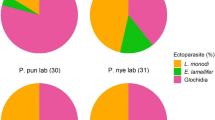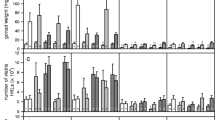Abstract
Hosts can protect themselves against parasites by actively reducing parasites burden (i.e. resistance) or by limiting the damages caused by parasites (i.e. tolerance). Disentangling between tolerance and resistance is important for predicting the evolutionary outcomes of host-parasite interaction. Dace (Leuciscus leuciscus) are often parasitized by the ectoparasite Tracheliastes polycolpus which feeds on (and destroys) fins, reducing thus the host’s condition. We tested the hypothesis that genetically-based variation in ectoparasite tolerance exists in a wild dace population. We found that moderately heterozygous dace, which are less resistant than highly heterozygous or homozygous dace, tolerated better the effect imposed by T. polycolpus for a given parasite burden. However, tolerance also varied upon environmental conditions, suggesting that genetic and environmentally-based variation exists for both resistance and tolerance in this natural host-parasite system. Moreover, a negative genetic correlation may exist between tolerance and resistance, and hence several evolutionary outcomes are possible in this interacting system.


Similar content being viewed by others
References
Allen SJ, O’Donnell A, Alexander NDE, Alpers MP, Peto TEA, Clegg JB, Weatherall DJ (1997) Alpha(+)-thalassemia protects children against disease caused by other infections as well as malaria. P Natl Acad Sci USA 94:14736–14741
Amos W, Wilmer JW, Fullard K, Burg TM, Croxall JP, Bloch D, Coulson T (2001) The influence of parental relatedness on reproductive success. P Roy Soc B 268:2021–2027
Antonovics J, Thrall PH (1994) Cost of resistance and the maintenance of genetic-polymorphism in host-pathogen systems. P Roy Soc B 257:105–110
Ayres JS, Schneider DS (2008) A signaling protease required for melanization in Drosophila affects resistance and tolerance of infections. Plos Biol 6:2764–2773
Balloux F, Amos W, Coulson T (2004) Does heterozygosity estimate inbreeding in real populations? Mol Ecol 13:3021–3031
Best A, White A, Boots M (2008) Maintenance of host variation in tolerance to pathogens and parasites. P Natl Acad Sci USA 105:20786–20791
Blanchet S, Rey O, Berthier P, Lek S, Loot G (2009a) Evidence of parasite-mediated disruptive selection on genetic diversity in a wild fish population. Mol Ecol 18:1112–1123
Blanchet S, Méjean L, Bourque JF, Lek S, Thomas F, Marcogliese DJ, Dodson JJ, Loot G (2009b) Why parasitized hosts look different? Resolving the “chicken-egg” dilemma. Oecologia 160:37–47
Blanchet S, Bernatchez L, Dodson J (2009c) Does interspecific competition influence relationships between heterozygosity and fitness-related behaviors in juvenile Atlantic salmon (Salmo salar)? Behav Ecol Soc 63:605–615
Blanchet S, Thomas F, Loot G (2009d) Reciprocal effects between host phenotype and pathogens: new insights from an old problem. Trends Parasitol 25:364–369
Boots M (2008) Fight or learn to live with the consequences? Trends Ecol Evol 23:248–250
Boots M, Bowers RG (1999) Three mechanisms of host resistance to microparasites—avoidance, recovery and tolerance—show different evolutionary dynamics. J Theoretic Biol 201:13–23
Chapman JR, Nakagawa S, Coltman DW, Slate J, Sheldon BC (2009) A quantitative review of heterozygosity-fitness correlations in animal populations. Mol Ecol 18:2746–2765
Coltman DW, Pilkington JG, Smith JA, Pemberton JM (1999) Parasite-mediated selection against inbred Soay sheep in a free-living, island population. Evolution 53:1259–1267
Corby-Harris V, Habel KE, Ali FG, Promislow DEL (2007) Alternative measures of response to Pseudomonas aeruginosa infection in Drosophila melanogaster. J Evol Biol 20:526–533
Crawley JM (2007) Statistics: an introduction using R. Wiley, Chichester
Ebert D (1994) Virulence and local adaptation of a horizontally transmitted parasite. Science 265:1084–1086
Fineblum WL, Rausher MD (1995) Tradeoff between resistance and tolerance to herbivore damage in a morning glory. Nature 377:517–520
Francis R (1990) Back-calculation of fish length: a critical review. J Fish Biol 36:883–902
Jokela J, Taskinen J, Mutikainen P, Kopp K (2005) Virulence of parasites in hosts under environmental stress: experiments with anoxia and starvation. Oikos 108:156–164
Koskela T, Puustinen S, Salonen V, Mutikainen P (2002) Resistance and tolerance in a host plant-holoparasitic plant interaction: genetic variation and costs. Evolution 56:899–908
Kover PX, Schaal BA (2002) Genetic variation for disease resistance and tolerance among Arabidopsis thaliana accessions. P Natl Acad Sci USA 99:11270–11274
Lieutenant-Gosselin M, Bernatchez L (2006) Local heterozygosity-fitness correlations with global positive effects on fitness in threespine stickleback. Evolution 60:1658–1668
Lively CM, Dybdahl MF (2000) Parasite adaptation to locally common host genotypes. Nature 405:679–681
Ma Y, Seiler KP, Eichwald EJ, Weis JH, Teuscher C, Weis JJ (1998) Distinct characteristics of resistance to Borrelia burgdorferi induced arthritis in C57BL/6N mice. Infect Immun 66:161–168
Miller MR, White A, Boots M (2006) The evolution of parasites in response to tolerance in their hosts: the good, the bad, and apparent commensalism. Evolution 60:945–956
Neff BD (2004) Stabilizing selection on genomic divergence in a wild fish population. P Natl Acad Sci USA 101:2381–2385
Ortego J, Aparicio JM, Calabuig G, Cordero PJ (2007) Risk of ectoparasitism and kestrel population genetic diversity in a wild lesser. Mol Ecol 16:3712–3720
Råberg L, Sim D, Read AF (2007) Disentangling genetic variation for resistance and tolerance to infectious diseases in animals. Science 318:812–814
Råberg L, Graham AL, Read AF (2009) Review. Decomposing health: tolerance and resistance to parasites in animals. Phil Trans Roy Soc B 364:37–49
Rausher MD (2001) Co-evolution and plant resistance to natural enemies. Nature 411:857–864
Read AF, Graham AL, Råberg L (2008) Animal defenses against infectious agents: is damage control more important than pathogen control? Plos Biol 6:2638–2641
Restif O, Koella JC (2004) Concurrent evolution of resistance and tolerance to pathogens. Am Nat 164:E90–E102
Reyjol Y, Lim P, Dauba F, Baran P, Belaud A (2001) Role of temperature and flow regulation on the Salmoniform-Cypriniform transition. Archiv Fur Hydrobiol 152:567–582
Roy BA, Kirchner JW (2000) Evolutionary dynamics of pathogen resistance and tolerance. Evolution 54:51–63
Simms EL, Triplett J (1994) Costs and benefits of plant-responses to disease-resistance and tolerance. Evolution 48:1973–1985
Theriault V, Garant D, Bernatchez L, Dodson JJ (2007) Heritability of life-history tactics and genetic correlation with body size in a natural population of brook charr (Salvelinus fontinalis). J Evol Biol 20:2266–2277
Williams TN, Wambua S, Uyoga S, Macharia A, Mwacharo JK, Newton C, Maitland K (2005) Both heterozygous and homozygous alpha(+) thalassemias protect against severe and fatal Plasmodium falciparum malaria on the coast of Kenya. Blood 106:368–371
Zar JH (1999) Biostatistical analysis. Prentice Hall International, Upper Saddle River
Acknowledgments
We kindly thank Frédéric Thomas, David J. Paez and Lars Råberg for their fruitful comments and discussion on this paper. Comments from three anonymous referees greatly improve the overall quality of the manuscript. We also would like to thank the many people from our lab who give a hand on the field, as well as Pauline Berthier and Roselyne Etienne who help with genotyping. This research was founded by the Agence de L’Eau Adour-Garonne.
Author information
Authors and Affiliations
Corresponding author
Rights and permissions
About this article
Cite this article
Blanchet, S., Rey, O. & Loot, G. Evidence for host variation in parasite tolerance in a wild fish population. Evol Ecol 24, 1129–1139 (2010). https://doi.org/10.1007/s10682-010-9353-x
Received:
Accepted:
Published:
Issue Date:
DOI: https://doi.org/10.1007/s10682-010-9353-x




